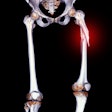Wednesday, December 3 | 10:40 a.m.-10:50 a.m. | SSK18-02 | Room S505AB
With radiation exposure to patients a constant concern, whole-body staging with PET/MRI could greatly benefit patients with non-small cell lung cancer (NSCLC).So concludes this study from University Hospital Zurich, which found that a 15-minute PET/MRI scan for NSCLC yielded diagnostic accuracy equal to PET/CT, but with less radiation.
"If PET/MRI proves to be a feasible clinical alternative to PET/CT in NSCLC patients, one potential benefit would be a reduction in radiation dose delivered to the patient," lead author Dr. Martin Huellner wrote in an email to AuntMinnie.com. "This would be relevant in patients with lower-stage tumors, who have a better chance of survival and will thus receive more follow-up exams."
The prospective study evaluated whole-body FDG-PET/CT and FDG-PET/MRI scans performed on 40 patients (median age, 65 years) with suspected or known NSCLC. MR images were acquired during the 15 minutes of PET acquisition time.
The researchers evaluated the results from PET alone, PET/CT, and PET/MRI separately and assessed tumor-node-metastasis (TNM) stages based on each modality's images. Consistently, TNM staging was equally accurate with PET/MRI and PET/CT, they noted.
Tumor staging by PET/MRI was correct in 20 patients (63%), compared with 22 patients (69%) for PET/CT. PET/MRI correctly handled node staging in 22 patients (69%), compared with 19 patients (59%) for PET/CT. PET/MRI correctly identified metastases in 24 patients (75%), compared with 20 patients (63%) for PET/CT.
Despite the similar results, PET/MRI still has to prove if it truly is a better alternative to PET/CT, Huellner said.
"Due to the better soft-tissue contrast of MRI, PET/MRI is thought to show more distant metastases to the liver and brain," he added. "There are, however, still drawbacks for lung imaging with MRI, as small lung metastases might be detected later than with PET/CT. The question remains if this is clinically relevant in this patient population."
Huellner believes that in patients with liver and/or brain metastases, PET/MRI could be preferred over PET/CT.
"Another scenario could be doing a whole-body PET/MR with or without a chest CT (if pathology is suspected in the lung), rather than using today's approach, which is basically the other way around -- whole-body PET/CT with or without an MRI of the brain, liver, etc., if pathology is suspected there," he said.




















